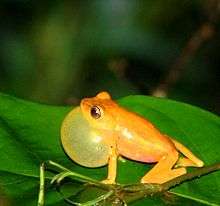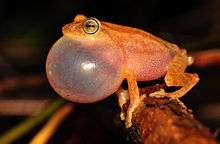Raorchestes luteolus
Raorchestes luteolus (sometimes known as Coorg yellow bush frog) is a species of frog in the family Rhacophoridae. It is endemic to the Western Ghats, India, where it is only known from the state of Karnataka. Many of the known populations are from the Kodagu district, known also by its anglicised former name of Coorg—hence the common name. It is also known from the Shimoga district in the Sharavathi basin where it was described as a new species, Philautus neelanethrus, but this is now considered to be a junior synonym of Raorchestes luteolus.[2][3]
| Raorchestes luteolus | |
|---|---|
 | |
| Scientific classification | |
| Kingdom: | Animalia |
| Phylum: | Chordata |
| Class: | Amphibia |
| Order: | Anura |
| Family: | Rhacophoridae |
| Genus: | Raorchestes |
| Species: | R. luteolus |
| Binomial name | |
| Raorchestes luteolus (Kuramoto and Joshy, 2003) | |
| Synonyms | |
|
Philautus neelanethrus Kuramoto and Joshy, 2003 | |
Description
Raorchestes luteolus is a small frog, males measuring 24–29 mm (0.94–1.14 in) in snout-vent length. Its colour is variable. The dominant colour form is yellowish brown with light-brownish lines or light-yellowish with discontinuous light-brown lines, but some individuals may be almost golden yellow with only faint spots. The iris is light brown encircled with a bluish green outer ring.[3]
Raorchestes luteolus is a close relative of Raorchestes travancoricus with which it can be confused. The distinguishing characters are its medium size (mean adult male snout-vent length 26.8 mm), pointed snout, rounded canthus, yellow or yellowish brown dorsum with dark brown spots and faint discontinuous lines, and loreal and golden yellow or yellowish brown tympanic regions.[3]
Habitat
Raorchestes luteolus are most commonly found in disturbed habitats, near coffee plantations adjacent to primary forests and waysides.[3] In Sharavathi it was also found from Myristica swamps.[4]
Behaviour
Raorchestes luteolus are often found on leaves or stems of shrubs about one metre above the ground. Male frogs start calling at dusk, first under the leaf litter and then ascending to the vegetation. Call characteristics may differ between populations; in particular, between the Sharavathi frogs described as Philautus neelanethrus and the nominal Raorchestes luteolus.[4]
Life cycle
The life cycle of Raorchestes luteolus is not known in any detail, but the observation of a pair in amplexus away from water suggests that it has direct development,[4] as is typical for the genus Raorchestes.[5]
Gallery
 Raorchestes luteolus from Kudremukh
Raorchestes luteolus from Kudremukh Raorchestes luteolus from Bisle
Raorchestes luteolus from Bisle.jpg) Raorchestes luteolus (Yellow bush frog)
Raorchestes luteolus (Yellow bush frog) Male Raorchestes luteolus vocalizing
Male Raorchestes luteolus vocalizing
References
| Wikimedia Commons has media related to Raorchestes luteolus. |
- Indraneil Das (2004). "Raorchestes luteolus". IUCN Red List of Threatened Species. 2004: e.T58867A11841647. doi:10.2305/IUCN.UK.2004.RLTS.T58867A11841647.en. Retrieved 3 January 2018.
- Frost, Darrel R. (2013). "Raorchestes luteolus (Kuramoto and Joshy, 2003)". Amphibian Species of the World 5.6, an Online Reference. American Museum of Natural History. Retrieved 8 November 2013.
- Biju, S. D.; Bossuyt, F. (2009). "Systematics and phylogeny of Philautus Gistel, 1848 (Anura, Rhacophoridae) in the Western Ghats of India, with descriptions of 12 new species". Zoological Journal of the Linnean Society. 155 (2): 374–444. doi:10.1111/j.1096-3642.2008.00466.x.
- Gururaja, KV; Aravind NA; Ali S; Ramachandra TV; Velavan TP; Krishnakumar V; Aggarwal RK (2007). "A new frog species from the central Western Ghats of India, and its phylogenetic position". Zoological Science. 24: 525–534. doi:10.2108/zsj.24.525. PMID 17867853.
- Biju, S. D.; Yogesh Shouche; Alain Dubois; S. K. Dutta; Franky Bossuyt (2010). "A ground-dwelling rhacophorid frog from the highest mountain peak of the Western Ghats of India" (PDF). Current Science. 98 (8): 1119–1125.
